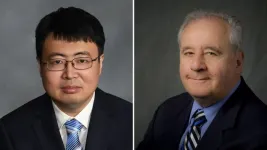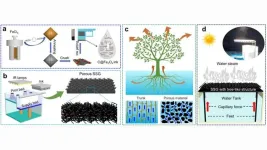The small but mighty device is a magnetron – a mashup of the words “magnetic” and “electron.” The term was coined in 1921, and the technology was once a wartime secret before making its way into billions of homes as the heart of the modern microwave oven.
Now, physicists and engineers at the U.S. Department of Energy’s Thomas Jefferson National Accelerator Facility are exploring magnetrons as the drivers of high-performance particle accelerators. This could lower the carbon footprint of these massive machines and help them benefit society far beyond scientific research.
Particle accelerators already equip technologies such as cancer therapy machines, industrial irradiators used for food sterilization, tire irradiation, and mail sanitization. Recent studies also have found potential in water treatment, chemical fabrication and security. But to make those energy-hungry, future applications practical, scientists and engineers need to find creative ways to bring down the price and improve overall efficiency.
That’s why the DOE’s Office of Science is funding a series of complementary projects aimed at adapting particle accelerators for industrial work. Led by Jefferson Lab, these stewardship grants seek compact accelerator technology enabled by novel superconducting materials, off-the-shelf cooling equipment, machine learning, and magnetrons as sources of radiofrequency (RF) fields. These projects, funded under the DOE’s aptly named “Research Opportunities in Accelerator Stewardship and Accelerator Development” and “Accelerate Innovations in Emerging Technologies” opportunities, are aimed at furthering the maturation of technologies to make hulking particle accelerators smaller and more efficient.
“Industry wants the compactness, the high efficiency, and the low cost,” said Haipeng Wang, a senior accelerator physicist at Jefferson Lab and the lead investigator on the magnetron study. His team is collaborating with private-sector firms and universities to develop scalable, low-cost magnetron systems that can drive a compact – and possibly portable – superconducting radiofrequency (SRF) accelerator.
Mighty Magnetrons
So what is a magnetron, anyway?
Not to be confused with Megatron from “Transformers,” Magneton from “Pokémon,” or Magneto from Marvel Comics’ “X-Men,” the unassuming magnetron apparatus is a type of vacuum tube that generates microwaves by crossing a stream of electrons with a magnetic field.
The most common rendition is a cavity magnetron. It’s essentially a copper cylinder with a central hole that’s surrounded by a series of bored chambers, likened to those in a revolver. In fact, early models were based on a Colt pistol design.
The cylinder is placed between the poles of a magnet, within a vacuum vessel. A high-voltage wire delivers electrons into the center of the device, and those negatively charged particles disperse outward within the cavity, spiraling in the magnetic field before being absorbed by the chambers’ copper surfaces. Launched at random, the electrons eventually distribute in synchronism with the chambers, causing the electric current to oscillate – i.e., create RF waves.
“When magnetrons are saturated, they reach the desired power at the defined frequency,” Wang said, “But to lock that frequency in, you have to act fast.”
The oscillating current and electron flow generate microwaves that can be fed into a waveguide, which is a type of duct designed to preserve radiofrequency and deliver its energy.
The cavity magnetron was once a highly guarded secret delivered to the U.S. from the U.K. for development during World War II, when it found widespread use by the Allied powers in early aircraft radar systems. After the global conflict, magnetrons made their way into radar for civil aviation and marine navigation, where they are still in use along with other rival vacuum tubes.
But it didn’t take long for the mighty, mouse-size gadget to find new life – and possibly by accident.
Beep, Beep, Beeeeep …
According to legend, physicist and inventor Percy Spencer was testing a magnetron-based radar system for U.S. defense contractor Raytheon in 1945 when a candy bar in his pocket started to get warm.
As told in a 1958 Reader’s Digest story and again by his grandson, Rod Spencer, in a 2015 Business Insider article, Percy Spencer thought the radar set might have melted the candy. So, he tried an experiment – this time with popcorn kernels. And, poof: the savory puffs sputtered and sailed all over his lab. More experiments followed, including an egg that exploded onto a fellow scientist’s face.
Two years later, the first commercial microwave oven was on the market. Appropriately, it was named the “Radarange.” But the original Radarange was nearly 6 feet tall, weighed roughly 750 pounds and cost about $5,000 (adjusted for inflation, that’s about $68,000 in today’s dollars). It wasn’t terribly efficient, either.
Despite the bulk and price, the race to bring affordable microwave ovens into the household was on. By 1967, the first popular countertop model was in production. Now, watching “Saving Private Ryan” with a bowl of popcorn is easier than ever.
“The magnetron is a tiny and compact device, but it’s very efficient,” Wang said. “When you turn on the microwave, you don't really worry about that part of electric bill because the efficiency is more than 70%.”
As an RF source for particle accelerators, magnetrons could provide an efficiency that surpasses 70%.
Magnetrons vs. Klystrons
Driving many of today’s high-performance accelerators are resonating RF fields inside specially designed, superconducting cavities that propel the charged particles, such as electrons or protons, used in physics research.
This includes Jefferson Lab’s Continuous Electron Beam Accelerator Facility (CEBAF), a world-class DOE Office of Science research machine relied on by a global community of more than 1,900 scientists studying the inner workings of matter.
CEBAF’s source of RF fields is one of the magnetron’s close cousins: the klystron. Both are high-power vacuum tubes, and both were featured in early aircraft radar systems during WWII. They differ in that klystrons are linear amplifiers, meaning they increase the magnitude of supplied radio waves. Magnetrons are nonlinear oscillators that generate microwaves through the circulation of electron current.
Klystrons offer a high output power with a great control of phase (frequency over time) and amplitude. CEBAF uses 418 of them, but their efficiency leaves room for improvement. That led Wang, who is also a designer of klystron systems, to begin exploring magnetrons in 2010 as RF sources for particle accelerators.
Wang’s recent “ARDAP” award, funded for three years, is the DOE’s second extension of his study of magnetrons as RF sources for compact, industrial accelerators. Meanwhile, his teammates Kevin Jordan and Robert Rimmer are working on a separate DOE grant for investigating magnetrons’ use in nuclear physics accelerators.
"Ultimately, the goal is driving CEBAF,” Wang said.
Wang’s studies show that magnetrons offer a much higher efficiency as an RF source – upwards of 80% – and would substantially cut costs. Coupled with novel SRF cavity materials and off-the-shelf cooling equipment, magnetrons also could help open the door to larger industrial and commercial markets.
Another attractive aspect is that many supporting components are already commercially available, and not just inside your microwave oven at home. Powerful magnetron systems have long been used in many food-processing plants and signal broadcasting systems, making their parts relatively inexpensive to obtain.
“Industrial food processors can put 10 magnetrons together and cook 2 tons of bacon in an hour,” said Kevin Jordan, a Jefferson Lab senior engineer who is part of the magnetron team. “Or, they can pump the energy into a 55-gallon drum to make salsa.”
But the technology isn’t ready for future particle accelerators just yet. In the meantime, there's still plenty of R&D to be done.
‘Popping’ Them In
One challenge with magnetrons is instability at different levels of output power. This owes itself to the system’s random electron distribution, frequency changes, and “noise” (like “static” on an AM radio) to overcome. To begin addressing this, Wang’s team uses extra wire coils to “trim” the magnetic field and bring the natural frequency within a range that can be “locked” with an injection signal within an SRF cavity bandwidth.
For cavities used in compact accelerators, the team is exploring frequencies of 915 MHz and 2.45 GHz. Those bands are already popular in household microwave ovens, commercial food processing, and signal broadcasting. Meanwhile, Jordan is spearheading a study of 1497 MHz – the frequency on which CEBAF’s cavities operate – with parts supplied by Illinois-based accelerator physics firm Muons, Inc.
“The frequency of the tube has to match that of the cavity very well,” Jordan said. “We can use an amplifier to push and pull a little, coaxing it along, but everything is about having the field in the cavity match the electrons.”
The Jefferson Lab team also is working to show that magnetron systems can be scaled up without losing much efficiency, through a process called power combining. For the 915 MHz study, this involves linking four, 75-kilowatt magnetron sources in what’s called a “Magic Tee.” Such a setup could provide a wall-plug to RF power efficiency of roughly 90%, at a much lower cost than traditional systems.
The 2.45 GHz station, provided by Jefferson Lab, will combine four, 1.2-kilowatt magnetrons at General Atomics, a California-based energy and defense R&D company. Key to all of this will be smart power-supply controllers, provided by Utah-based manufacturer InnoSys, Inc., a U.S. Small Business Innovation Research awardee. These electronics will use field-programmable gate arrays to allow rapid modulation of anode and trim-coil currents.
“We need to have multiple feedback loops and multiple working points, so the controller study is critical for magnetron operation,” Wang said. “The smart controller and power supply have to be more efficient and faster compared to traditional techniques.”
Wang’s team plans to conduct more research and development for controlling amplitude, phase-locking and noise reduction. Later, they will deliver their work to General Atomics, which will further study the efficiency, scalability, and operational stability of these combined systems. Putting it all together could bring down the energy costs of magnetron systems to about $1.50 per watt and even save CEBAF’s operators as much as $2 million a year – based on kilowatt-hours and Virginia’s current electricity rates.
“This is a wonderful story of collaborative R&D from fundamental research that we started some 15 years ago,” Wang said. “There are so many good people on the team, from industry to research institutions, to universities. We are glad to be a part of that.”
The “Accelerate” and “ARDAP” teams and Jefferson Lab’s Research and Technology Partnerships Office welcome opportunities for future collaboration.
Further Reading
Adapting Particle Accelerators for Industrial Work
Conduction-cooled Accelerating Cavity Proves Feasible for Commercial Applications
Award enables research for more efficient accelerators
Scientists Seek to Harness the Power of Accelerators for Environmental Remediation
Liquid Helium-Free SRF Cavities Could Make Industrial Applications Practical
-end-
Jefferson Science Associates, LLC, manages and operates the Thomas Jefferson National Accelerator Facility, or Jefferson Lab, for the U.S. Department of Energy's Office of Science. JSA is a wholly owned subsidiary of the Southeastern Universities Research Association, Inc. (SURA).
DOE’s Office of Science is the single largest supporter of basic research in the physical sciences in the United States and is working to address some of the most pressing challenges of our time. For more information, visit https://energy.gov/science
END




